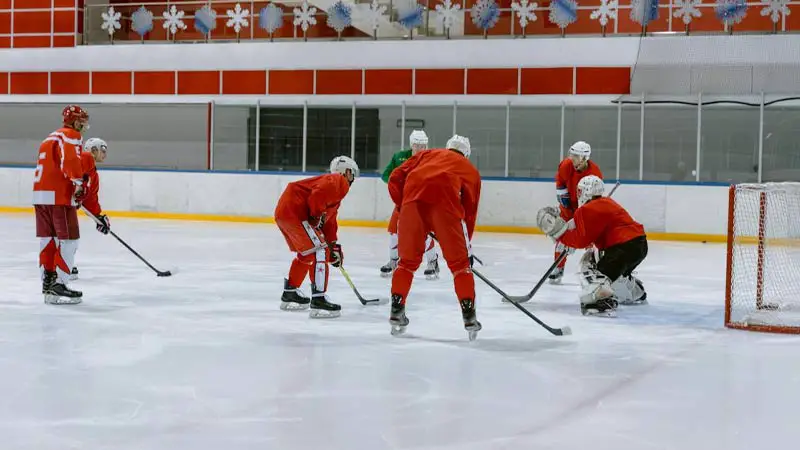In the high-octane world of hockey, a goal is more than a mere point on the scoreboard. It’s the culmination of skill, strategy, and precision that can alter the course of a game.
Understanding what constitutes a goal in hockey goes beyond the excitement of the moment; it delves into the sport’s fundamental principles.
From the intricacies of puck placement to the role of technology in officiating, this blog post will unravel the layers of significance that define a goal in the fast-paced world of hockey.
Whether you’re a seasoned fan or a newcomer to the sport, this exploration will provide a comprehensive insight into the nuanced art of scoring in hockey. So, stay calm and read the whole post.
What Is a Goal in Hockey?
In hockey, a goal is the ultimate achievement, marking the successful propulsion of the puck across the goal line into the opponent’s net. It signifies a scoring event and contributes to a team’s overall point tally.
To be considered a valid goal, the entire puck must completely traverse the goal line between the goal posts and beneath the crossbar.
The act of scoring is not only a moment of celebration for the attacking team but also a crucial element that can sway the course of a game.
Goals are pivotal in determining the winner and are often accompanied by cheers from fans and teammates.
The precision of goal-scoring is a testament to the players’ skill, accuracy, and strategic prowess in navigating the fast-paced and dynamic nature of the sport.
The Basics of a Hockey Goal
Understanding the fundamental elements of a hockey goal is crucial for players, coaches, and enthusiasts alike.
A hockey goal is not just a mere structure; it plays a pivotal role in the dynamics of the game.
Let’s delve into the basics of a hockey goal to gain a comprehensive understanding of its components and significance.
Frame Structure and Dimensions
The frame is the skeleton of a hockey goal, typically made of sturdy materials like steel or aluminum.
Regulation goals are rectangular and measure 6 feet in width and 4 feet in height. The frame provides the structure for the netting and ensures the goal’s stability during intense game moments.
Netting
The netting is an integral part of the goal, serving as the barrier through which players must propel the puck to score. It is usually made of nylon and is attached securely to the frame.
The mesh size and thickness are standardized to maintain consistency across different games and competitions.
Goal Posts and Crossbar
The goal posts and crossbar are essential components that define the scoring area. The posts are vertical bars at each end of the goal, while the crossbar connects them horizontally at the top.
For a goal to be valid, the puck must completely cross the goal line between the posts and beneath the crossbar. These dimensions are carefully regulated to ensure fairness and uniformity in the sport.
Goal Line
The goal line is the boundary that determines whether a goal has been scored. It is an imaginary line extending between the goalposts and beneath the crossbar. When the entire puck crosses this line, a goal is awarded.
The precision of goal-line decisions has been enhanced in modern hockey with the introduction of technologies like goal-line cameras to assist referees in making accurate calls.
Goalie Crease
The goalie crease is a designated area in front of the goal, marked by semi-circular lines. This space is exclusively for the goaltender, providing them with a zone where they have certain privileges and limitations.
Opponents are generally not allowed to enter the crease unless the puck is already inside. Understanding the dynamics of the goalie crease is essential for both offensive and defensive strategies during gameplay.
The basics of a hockey goal encompass more than just a frame and net.
Types of Hockey Goal

Hockey, a sport celebrated for its dynamic nature, features various types of goals that players employ strategically.
Understanding these different goal types adds depth to the game and showcases the versatility of players on the ice.
Power Play Goal
A power-play goal occurs when a team scores while enjoying a numerical advantage due to the opposing team having a player in the penalty box.
Teams capitalize on this opportunity, utilizing the extra player to create offensive plays and enhance their scoring chances.
Breakaway Goal
The breakaway goal is a thrilling spectacle where a player successfully maneuvers the puck past all opposing players, finding themselves one-on-one with the goalie.
This type of goal emphasizes a player’s speed, agility, and composure in high-pressure situations.
Rebound Goal
A rebound goal transpires when a player capitalizes on the puck’s rebound off the goalie’s pads or equipment, seizing the opportunity to swiftly score.
These goals often require quick reflexes and a sharp offensive instinct to exploit the vulnerability created by the initial shot.
Wrap-around Goal
The wrap-around goal involves a player carrying the puck behind the opposing team’s net and quickly wrapping it around the post to score on the opposite side.
This maneuver catches goalies off guard, relying on the element of surprise and swift execution.
Deflection Goal
A deflection goal occurs when a player redirects a teammate’s shot into the net using their stick.
It demands precise timing and hand-eye coordination, as the player must alter the puck’s trajectory while positioned in a high-traffic area in front of the net.
Understanding and appreciating these distinct goal types not only adds excitement for spectators but also showcases the diverse skill sets and strategic acumen of hockey players.
Hockey Goal Statistics

Analyzing hockey goal statistics is essential for teams, coaches, and fans alike, providing valuable insights into a player’s performance, team dynamics, and overall game trends.
These statistics go beyond the simple count of goals, offering a nuanced understanding of the sport’s intricacies.
Goals Scored per Game
A fundamental statistic, goals scored per game, reflects a team’s offensive efficiency.
It serves as a key indicator of their ability to capitalize on scoring opportunities and can influence strategies for both offensive and defensive plays.
Teams with higher goal-scoring averages often exhibit potent offensive capabilities.
Power Play Efficiency
Power play efficiency measures a team’s success in scoring goals when they have a numerical advantage due to penalties against their opponents.
A high power play efficiency indicates a team’s ability to exploit these opportunities, showcasing skilled puck movement and effective playmaking during power plays.
Shooting Percentage
Shooting percentage calculates the ratio of goals scored to the total number of shots taken.
This statistic provides insights into a player’s accuracy and efficiency in converting shots into goals. It’s a valuable metric for evaluating individual player performance and offensive strategies.
Goalie Save Percentage
Goalie save percentage is a critical metric for evaluating goaltender performance. It calculates the percentage of shots on goal that a goalie successfully saves.
A high save percentage indicates a goaltender’s effectiveness in preventing goals, showcasing their skill, reflexes, and ability to keep their team competitive.
Game-Winning Goals
Tracking game-winning goals highlights a player’s ability to make a significant impact during crucial moments.
Whether it’s breaking a tie or securing a lead, players with a high number of game-winning goals demonstrate a penchant for delivering when the stakes are high, contributing to their team’s success.
Hockey goal statistics offer a comprehensive view of a team’s and players’ performance beyond the final score.
Defending A Goal in Hockey

Defending a goal in hockey is a multifaceted skill that requires a combination of strategy, teamwork, and individual prowess.
A strong defensive approach is crucial for preventing the opposing team from scoring and maintaining a competitive edge in the game.
Positioning and Zone Defense
Effective defending starts with strategic positioning. Players must maintain a balance between protecting the goal and pressuring the opponents.
Utilizing zone defense involves players covering specific areas on the ice, ensuring comprehensive coverage, and minimizing the chances of the opposing team making successful offensive plays.
Stick Checking and Body Position
Stick checking is a fundamental defensive technique where players use their sticks to disrupt the opponent’s puck control and passing.
Maintaining proper body position is equally important, ensuring defenders can effectively impede the progress of attacking players without committing penalties. A well-timed stick check can disrupt plays and create turnovers.
Shot Blocking
Shot blocking is a courageous defensive tactic where players use their bodies to intercept and block incoming shots.
This skill requires precise timing, as mistimed attempts can result in injuries or inadvertently redirecting the puck toward the goal.
Players adept at shot blocking contribute significantly to their team’s defensive resilience.
Goalie Communication and Saves
Clear communication between defenders and the goaltender is paramount in thwarting scoring attempts. Defenders must communicate the position of opponents, ensuring the goalie is aware of potential threats.
A skilled goaltender can make critical saves, preventing goals even in high-pressure situations, and their ability to read the game is instrumental in organizing defensive plays.
Penalty Killing
Penalty killing is an essential aspect of defensive play, especially when a team is down a player due to penalties.
Effective penalty killing involves disciplined play, aggressive pursuit of the puck, and the ability to clear it from the defensive zone.
Successfully killing penalties not only prevents goals but can also shift momentum in favor of the defending team.
Defending a goal in hockey requires a combination of strategic positioning, skillful techniques, and effective communication among players.
FAQs
What constitutes a valid goal in hockey?
A valid goal in hockey occurs when the entire puck crosses the goal line between the goalposts and beneath the crossbar. It’s a precise requirement to ensure fairness and accuracy in scoring.
How does the referee determine if a goal is scored?
Referees use various tools, including goal-line cameras and their on-ice perspective, to confirm if the puck completely crosses the goal line.
Video review technology assists in making accurate and conclusive goal decisions.
Are there different types of goals in hockey?
Yes, hockey features various goal types, including power-play goals, breakaway goals, rebound goals, wrap-around goals, and deflection goals.
Each highlights different player skills and strategic plays during a game.
Can a goal be scored from anywhere on the ice?
Yes, a goal can be scored from any location on the ice. As long as the puck meets the criteria of crossing the goal line within the defined parameters, it counts as a valid goal regardless of where the shot originated.
What role do goal statistics play in hockey?
Goal statistics provide crucial insights into a team’s offensive prowess, individual player performance, and overall game dynamics.
Metrics like goals per game, power play efficiency, and shooting percentage help assess a team’s competitiveness and player contributions.
Wrapping Up
In the realm of hockey, a goal is the heartbeat of the game a momentous achievement that echoes beyond the rink. It encapsulates the fusion of athleticism, strategy, and sheer determination.
Whether it’s a power play, breakaway, or deflection, each goal tells a unique story of skill and precision.
This exploration into the essence of hockey goals has uncovered the intricacies that make them more than just numerical entries on a scoreboard.
It’s a journey through the thrilling narratives written on the ice, reminding us that in hockey, a goal is not merely a point; it’s a testament to the artistry and passion that define this exhilarating sport. Thank you so much.








James Felix